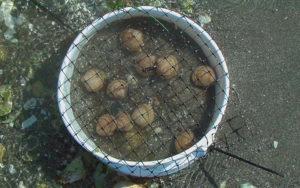
Cockle project provides aquaculture option for British Columbia first nations
Cockles are a common, though not overly abundant, bivalve in British Columbia waters, where they are normally found in low intertidal and subtidal regions.
Zeolite is used in industry for water softening and as media for molecular sieves but has no real benefit for aquaculture in ammonia removal.

Cockles are a common, though not overly abundant, bivalve in British Columbia waters, where they are normally found in low intertidal and subtidal regions.

Bangladesh may be a small player in terms of global shrimp production, but producing and exporting shrimp provides an important source of foreign exchange.

Tilapia culture systems in Bangladesh play a “silent” role in meeting poor peoples’ needs and, increasingly, of a growing demand in formal markets.

Small autonomous vehicles provide an environmentally friendly approach to labor-intensive methods used to maintain production and water quality.

Total suspended solids concentration is time-consuming to measure, but turbidity has been used to estimate TSS concentrations in some types of effluents.

Since the application of mineral salts to correct ionic imbalances has improved survival and production, the practice is becoming increasingly common.

A technique to stimulate oyster growth in the form of an oyster reef breakwater is being developed at Louisiana State University in Baton Rouge.

Pure oxygen transfer columns and vacuum degassing columns can be used to drive dissolved nitrogen gas concentrations down to sub-saturation levels.

Intensive recirculation systems have potential for increased production per unit volume of water, but an increased risk of equipment failures.

Grow-out studies of summer flounder at the University of North Carolina Wilmington evaluated microbead media as a biofilter in recirculating systems.

While membrane filtration is not a cost-effective alternative to coarse solids removal processes, it has potential niche applications.

Chemical fertilizers are frequently used in pond aquaculture to stimulate phytoplankton productivity and enhance the availability of natural food organisms.

Acidification due to excavation and aeration of acid sulfate soil causes recurrent production losses and low yields in brackish water aquaculture.

Negative impacts from uncontrolled populations of phytoplankton can provide a major production challenge in pond aquaculture systems used for catfish.

Organic matter – including fertilizers, unconsumed feed and feces of culture animals – settles to pond bottoms, often with a negative impact on water quality.